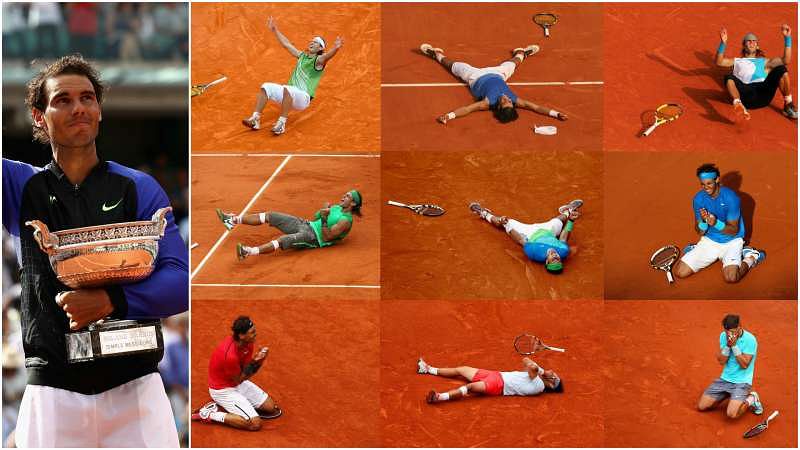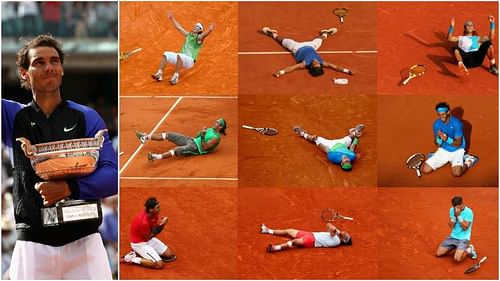
La Decima: How Nadal won 10 French Open titles

Rafael Nadal made history on Sunday, becoming the first player in the Open Era to win the same major on 10 separate occasions with victory over Stan Wawrinka in the French Open final.
The Spaniard swept all before him in Paris, racing to the final without dropping a set and continuing that record with a 6-2 6-3 6-1 triumph over the Swiss, who suffered his first defeat in the final of a grand slam.
It represented a 15th major win for Nadal, who is now clear of Pete Sampras' haul of 14 and just three back of long-time rival Roger Federer.
Having completed an unprecedented feat that seems unlikely to be matched in the near future, we analyse how Nadal - the undisputed 'King of Clay' - built a legacy that ensured his place in tennis folklore.
10 titles. 10 unforgettable moments for @RafaelNadal.
— Roland-Garros (@rolandgarros) June 11, 2017
10 titres, 10 moments de bonheur sur la terre battue de Roland-Garros #LaDecima pic.twitter.com/4e8rRCiyxw
Number One - 2005
A teenage Nadal was among the favourites as he went into his first French Open on the back of a 17-match winning streak. He had already won five titles on the ATP Tour that year and was ranked fifth in the world at the start of the tournament. He beat Xavier Malisse, Richard Gasquet and David Ferrer in straight sets en route to a semi-final against world number one and career Grand Slam-chasing Roger Federer. Nadal had lost a five-set thriller with the Swiss in Miami in April but was triumphant on his 19th birthday to book a place in the final, where he dispatched of the unseeded Mariano Puerta 6-7 (6-8) 6-3 6-1 7-5.
Number Two - 2006
The year got off to a frustrating start for Nadal as a foot injury ruled him out of the Australian Open, but he once more arrived at Roland Garros on the back of a 17-match winning streak. Included in that run were Monte Carlo and Rome final victories over Federer, who he also beat in Dubai in March, and the pair went head to head again in the French Open final. Federer took the opening set 6-1 but Nadal rallied back impressively to retain his crown with a 1-6 6-1 6-4 7-6 (7-4) triumph. The long-haired Spaniard had denied the Swiss the chance to hold all four grand slams at the same time.
Number Three - 2007
Defeat to Federer in the final of an ATP 1000 event in Hamburg in May seemed to suggest Nadal's love affair with Roland Garros could be set for a break. The Spaniard had other ideas, though. He marched to the final without dropping a set, defeating Lleyton Hewitt and Novak Djokovic en route, before once more coming out on top on the Parisian clay as one of the sport's greatest rivalries continued to develop. Federer's hopes of being champion of all four majors simultaneously dashed by his young rival once more.
Number Four - 2008
Nadal avenged his Hamburg defeat to Federer a year prior with a straight-sets victory over the Swiss, priming him for a fourth successive triumph at the French Open - the Spaniard had also won their previous 2008 meeting at the Monte-Carlo Masters. An utterly dominant display from Nadal saw him surge to the title without dropping a set, overcoming Djokovic in the semis before a sensational 6-1 6-3 6-0 triumph over Federer in the final. Federer may have had 12 grand slam titles in his possession, but Nadal's dominance on clay meant glory at Roland Garros continued to evade him. To rub salt into the wounds, the Spaniard would end the year at the top of the rankings for the first time in his career.
Number Five - 2010
After being handed his first taste of defeat at Roland Garros following 31 successive wins by Robin Soderling amid the start of persistent knee issues in 2009, a result that enabled Federer to end his long wait to claim the Coupe des Mousquetaires for the first time in his career, Nadal provided the most emphatic of responses. This time he did not have to come up against Federer; instead he faced the Swiss' conqueror and the man who had dumped him out a year prior – Soderling. Nadal did not err against the world number seven, taking the title without dropping a set for the second time after a 6-4 6-2 6-4 win in the final. It was the first of three straight major wins for the Spaniard, whose Grand Slam was completed with victory in the US Open of that year.
Getting the silverware ready for @RafaelNadal...#RG17 pic.twitter.com/1F1Bt7rRWZ
— Roland-Garros (@rolandgarros) June 11, 2017
Number Six - 2011
Normal service was resumed as Nadal and Federer met in the main event once again. Djokovic had defeated Nadal on the clay of Madrid and Rome, but the Serbian was denied a place in the final by third seed Federer. The Swiss was unable to follow up that victory, though, as Nadal's dominance eventually showed in a 7-5 7-6 (7-3) 5-7 6-1 triumph. It remains their most recent meeting at Roland Garros, with Nadal holding a perfect 5-0 record.
Number Seven - 2012
Another great rivalry had begun to emerge with Djokovic having responded to his defeat to Federer in the 2011 French Open semi-finals by winning Wimbledon, the US Open and the Australian Open at the next three majors. Nadal was beaten in all three of those showpieces, but he gained vengeance by denying the Serbian in his first attempt to complete a career Grand Slam. The Spaniard had beaten Djokovic in Monte Carlo and Rome and he made it a hat-trick with a 6-4 6-3 2-6 7-5 victory in Paris.
Number Eight - 2013
Nadal's powerful running was thought to be a major factor behind ongoing knee issues, with tendonitis ruling him out of the 2012 US Open. He sat out the following Australian Open due to a stomach virus, meaning he spent close to six months off the Tour. It did not stop him from going all the way at Roland Garros, though. He had put together a 15-match winning streak that included titles in Barcelona, Madrid and Rome and extended it to 22 with a straight-sets win over countryman David Ferrer in the final. However, it was an incredible 6-4 3-6 6-1 6-7 (3-7) 9-7 semi-final success against Djokovic that was the stand-out moment in his eighth title in Paris.
Number Nine - 2014
Nadal began the year with defeat to Wawrinka in the Australian Open final, but his performance in Melbourne had been hampered by a back problem tweaked in the warm up. The Spaniard went to Roland Garros with just one clay-court title under his belt that year – the Madrid Open – and having gone down to Djokovic in Rome. However, he made history with his fifth straight French Open title outstripping the four in succession claimed by the legendary Bjorn Borg. Nadal comfortably overcame Andy Murray in the semi-finals and fought from a set down to beat Djokovic 3-6 7-5 6-2 6-4 in the final, but it would be, by his own stunning standards, a long wait for his next taste of grand slam glory.
Number Ten - 2017
With Nadal having entered his 30s and injury problems continuing to plague him – a wrist injury forced him to curtail his 2016 season in October – questions were asked as to whether he would add to his haul of 14 grand slams. There were promising signs at the Australian Open but Federer, himself having overcome knee and back issues, was too good in the Melbourne final. Nadal was at home on the clay, though. After winning his 10th titles in Monte Carlo and Barcelona – a feat no other man has achieved in a single event in the Open Era – he completed 'La Decima' at Roland Garros with an imperious 6-2 6-3 6-1 victory over Wawrinka. His place in history guaranteed for years to come with an achievement it seems unlikely will be matched.
#CHAMP10N pic.twitter.com/BV0M1qE7NE
— Rafa Nadal (@RafaelNadal) 11 June 2017